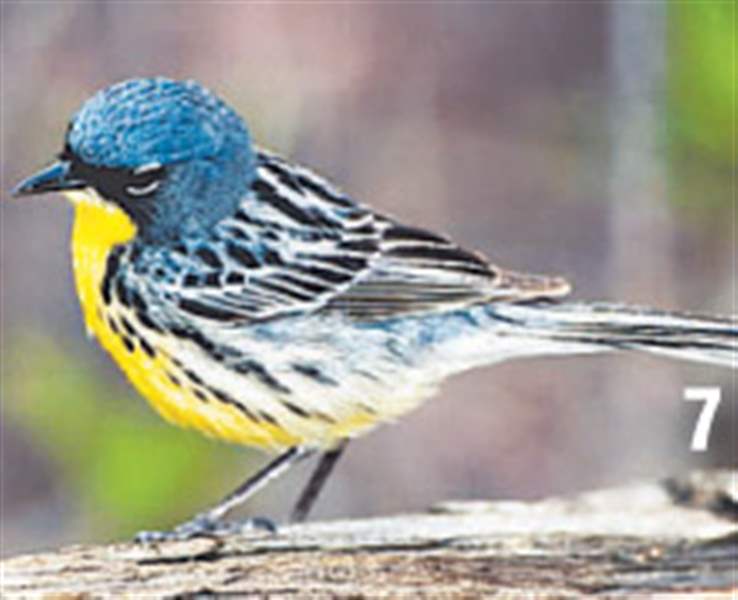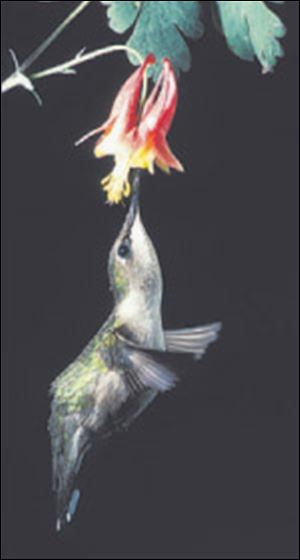
Northwest Ohio is a key stopover for many migrating birds
6/3/2007
Kirtland warbler

Ruby-throated hummingbird
They are called migratory stopover sites, but you can think of them as truckstops for birds.
They are a haven from the long over-the-road haul places for food, fuel, and rest. And the feathered convoys on the aerial highway north need to be fueled and rested, for just ahead on the aerial highway north is a major road hazard, Lake Erie.
The stopover sites may be no more than a few hundred square feet to a few hundred acres in size, but each one is important.
Wooded beach ridges, marshlands, seasonal mudflats, and more, even the shallows just offshore.
The western Lake Erie shoreline zone from Toledo to Huron, Ohio, has a critical concentration of such habitats. Each spring they are splashed with color and feathered diversity as neotropical songbirds, shorebirds, waterfowl, and birds of prey 300 species or more move north from as far away as South America.
Warblers, flycatchers, thrushes, sandpipers, plovers, hawks, ospreys, ducks, geese many of them are bound for summer nesting grounds in latitudes as northerly as the Canadian and Alaskan arctic.
A consortium of private and public conservation interests, funded by a grant from the George Gund Foundation, is calling attention to bird truckstops here in hopes that they will be wellmanaged and maintained. The cooperators in the study include researchers from the U.S. Fish & Wildlife Service, Ohio Division of Wildlife, Ohio State University, and the Black Swamp Bird Observatory, Ducks Unlimited, and the Nature Conservancy.
The idea is to identify the sites, rate their importance, and raise awareness of them, then guide efforts to conserve them, whether public or private, to the benefit of the birds. A parallel might be the Green Ribbon Initiative of the Oak Openings region on Toledo s western edge. There a consortium of public agencies, businesses, and private individuals are working on ways to conserve the globally rare habitat of oak savanna.
The islands and marshes of Lake Erie s western basin are one of the most important places in eastern North America for migratory birds, said Dave Ewert, director of conservation science of TNC s Great Lakes program office.
The Conservancy, via a grant from the Kelvin and Eleanor Smith Foundation, has established a challenge fund to raise money for protecting migratory bird habitat in northern Ohio and in Central America s Belize, where many birds spend the winter. It also has compiled composite maps of the sites that rate their relative importance in the western basin shore zone.
Interestingly, some of the sites are not land at all, but the shallow waters of Maumee Bay and vicinity. These are resting and rafting areas for squadrons of waterfowl and waterbirds, many of which are just passing through.

Kirtland warbler
Many stopover sites already are set aside in public conservation areas such as the Ottawa National Wildlife Refuge complex, Magee Marsh State Wildlife Area, portions of Maumee Bay State Park, and similar holdings.
But because stopover sites are frequently small and sometimes used by birds only a few days a year, many additional ones may be hard to identify and face serious threats from human development, according to the Conservancy.
Indeed, a site might become a casualty by accident it simply may not be recognized as important. Hence the mapping effort.
Studies show that the bulk of adult songbird mortality occurs during migration, Mr. Ewert noted. These birds can lose considerable body weight during the long migration journeys, and without places to rest and refuel, their ability to migrate is jeopardized.
For the birds it is all about laying on fat. It is their fuel, and their tanks are low when they arrive at the lakefront and vicinity after hundreds of miles of flying. Fat is the currency of migration, said Paul Rodewald, a wildlife ecologist at OSU.
Randy Edwards, a Conservancy spokesman, noted that protecting and managing known stopover sites can include anything from participation, where possible, in such federal efforts as the Conservation Reserve Program and Conservation Reserve
Enhancement Program to agreeing to conservation easements, or even acquisition of sites from willing sellers by public conservation agencies.
So, Mr. Ewert added, there are many ways to help the birds even in someone s backyard.
For other details, visit www.nature.org, and type in stopover sites in the search box.